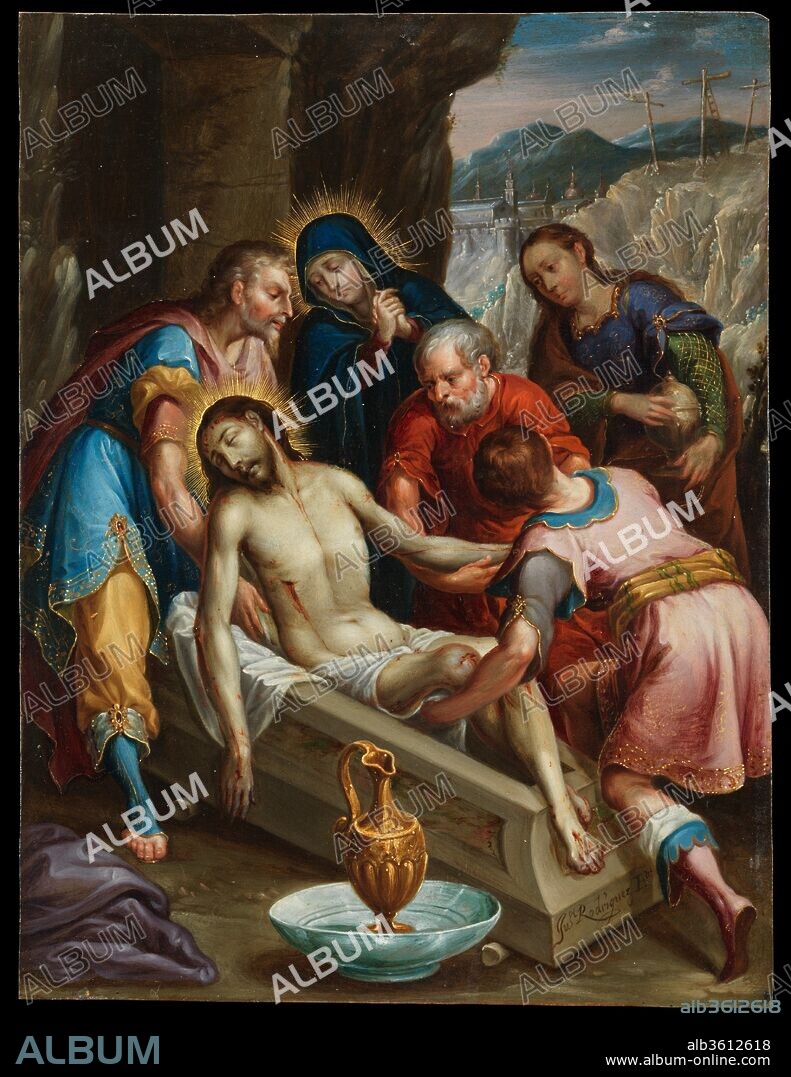alb3612618
JUAN RODRÍGUEZ JUÁREZ. The Entombment of Christ

|
Add to another lightbox |
|
Add to another lightbox |



Buy this image.
Select the use:

Title:
The Entombment of Christ
Caption:
The Entombment of Christ. Artist: Juan Rodríguez Juárez (Mexican, 1675-1728). Dimensions: 10 3/16 × 7 3/4 in. (25.9 × 19.7 cm)
Framed: 17 3/4 × 15 3/4 × 1 1/2 in. (45.1 × 40 × 3.8 cm). Date: ca. 1702.
Juan Rodríguez Juárez was a third generation painter who belonged to a celebrated artistic dynasty whose members included Luis Juárez (c. 1585-1639), José Juárez (1617-1661), Antonio Rodríguez (1636-1691), and Nicolás Rodríguez Juárez (1667-1734). He was a versatile artist who excelled as a painter of altarpieces and ecclesiastical decorations, as well as portraits, castas, and small devotional paintings such as The Entombment of Christ. This beautifully preserved work exemplifies his status as a key transitional figure in New Spanish painting. His stylistic trajectory, which is firmly rooted in the late 17th century, also reflects the innovations that marked painting in Mexico during the first quarter of the 18th century. As the co-founder of an informal academy, he is also a key figure in the struggle of Mexico's painters to reform their practice and elevate their social and professional standing. The Entombment of Christ belongs to the earliest phase of the artist's career and displays the brilliant color and vigorous modeling found in his 1702 altarpiece of St. Francis Xavier in Puebla Cathedral. Later works are characterized by greater softness and luminosity, traits that can be attributed to the taste for French art that coincided with the advent of the Spanish Bourbon monarchy at the turn of the century.
In Rodríguez Juárez's painting, Christ's body is gently lowered into a stone sepulchre by Joseph of Arimathea and Nicodemus. The scene is attended by the grieving figures of the Virgin and Mary Magdalene, who gaze on Christ's lifeless body. The drama takes place at the rocky entrance to a mountainside crypt, with Golgotha visible in the distance. Christ's purple garments lie discarded in the foreground alongside a pitcher and basin used to wash his body for burial. At the foot of the tomb, the artist's signature is prominently displayed.
The composition of this painting derives from a print by the Flemish engraver, Johannes Sadeler, after a drawing by Dirck Barendsz (Rijksmuseum, Amsterdam). The same print was used as a model by the manuscript illuminator, Luis Lagarto, in 1612 (Andrés Blaisten Collection). Lagarto follows the print in every detail, except, crucially, the position of Christ's head. In Sadeler's print, his head is thrown back and his face is completely obscured, whereas in the illumination, his head is turned to face the viewer. Rodríguez Juárez repeats this detail and further revises the composition by reducing the number of figures attending Christ's entombment. These changes heighten the impact made by the presentation of Christ's semi-nude body, which is displayed as the focus of prayer and meditation. Not only does the painter follow Lagarto's revision of Sadeler's print, he is also clearly inspired by the illuminator's exquisite technique. Like the illumination, the painting is delicately rendered in jewel-like colors and has fine touches of gold that describe the halos and accentuate the richness of the garments. The painting most likely formed part of a series, which may have included The Road to Calvary (Musée Goya, Castres), which has identical dimensions and is datable on stylistic grounds to the same period.
Ronda Kasl.
Technique/material:
Oil and gold on copper
Museum:
Metropolitan Museum of Art, New York, USA
Credit:
Album / Metropolitan Museum of Art, NY
Releases:
Model: No - Property: No
Rights questions?
Rights questions?
Image size:
3286 x 4256 px | 40.0 MB
Print size:
27.8 x 36.0 cm | 11.0 x 14.2 in (300 dpi)
 Pinterest
Pinterest Twitter
Twitter Facebook
Facebook Copy link
Copy link Email
Email
